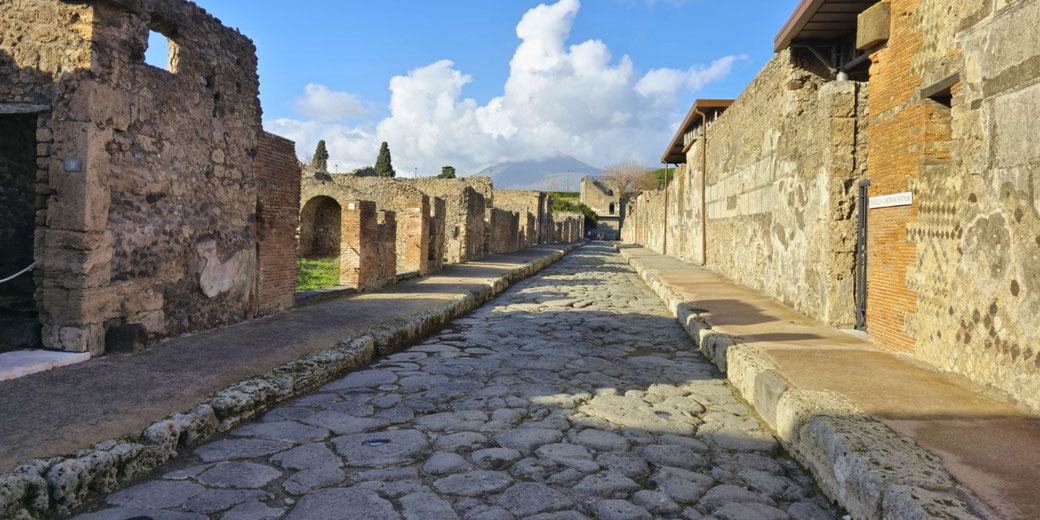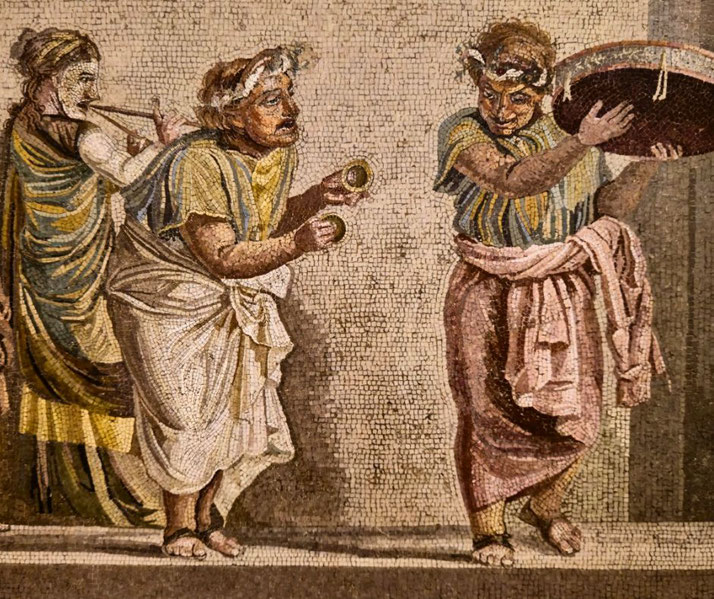Sights, smells, and violent crime: what it was like to walk on the streets of Ancient Rome

Imagine the soles of your sandals grating against the worn, uneven cobblestones as you walk the bustling streets of ancient Rome.
The resonant sounds of traders haggling in the marketplace blend harmoniously with the distant roars of a crowd in the Colosseum.
A whiff of fresh bread from a bakery mingles with the less appealing odors of a city at work, creating a distinctly Roman sensory tableau.
As you navigate the human ebb and flow, dodging a speedy chariot here, pausing to admire a public fountain there, you can't help but feel an electrifying sense of connection with the pulsating heart of an empire.
But what did it truly feel like to walk these streets two millennia ago?
What sights, sounds, and smells would one encounter?
What social interactions took place on these streets?
How safe were they, really?
Welcome to the ancient city of Rome
The ancient city of Rome, known as "The Eternal City", was the epicenter of one of history's greatest empires.
Its story unfolds over a thousand years, beginning with its legendary foundation by Romulus in 753 BC and culminating in the fall of the Western Roman Empire in AD 476.
At its zenith, Rome was a cosmopolitan metropolis, boasting a population of over a million people—a staggering number for the ancient world.
Rome began as a small settlement on the Tiber River and gradually expanded its influence, first over the Italian peninsula, and later across the Mediterranean and beyond.
The city was strategically situated in central Italy, making it a natural hub for trade and transportation, as well as military expeditions.
During the reign of Augustus, the first Roman Emperor, the city experienced a period of peace and prosperity known as the Pax Romana, during which its streets and buildings were significantly developed and adorned.
Rome's streets bore witness to a series of historical and cultural shifts—from the era of kings to the Roman Republic, and then to the Imperial age.
They hosted triumphant military parades, religious processions, political debates, public executions, and more.
The everyday life and grand historical events that took place on these streets are etched into the very fabric of the city, telling a story of human ambition, ingenuity, and resilience.
The confusing streets of an unplanned city
The design of ancient Rome's cityscape was an amalgamation of organic growth and planned development, a testament to centuries of expansion, fires, and rebuilding.
The cityscape was a rich tapestry of narrow, winding alleyways and grand, straight boulevards, reflecting the complex and layered history of Rome.
From its inception, Rome exhibited certain elements of strategic planning. The city was strategically located on seven hills, providing natural defense and access to the Tiber River.
The traditional heart of the city, the Roman Forum, served as a focal point around which public buildings and spaces were centered.
During the time of the Roman Republic, much of the city's layout was unplanned, resulting in a warren of narrow, winding streets and alleys.
However, following the Great Fire of Rome in AD 64, the Emperor Nero implemented a more organized city plan, with wider, straight roads for better access and fire control.
The roads, or 'viae,' were marvels of engineering and a testament to Roman ingenuity.
Viae were typically straight and connected important public spaces, like the Forum, bathhouses, markets, and theaters.
The most important roads, like the Via Appia, were paved with large stone blocks, lined with footpaths, and even had drainage systems.
Roman architecture was another distinguishing feature that greatly influenced the streetscape.
Monumental arches, ornate columns, towering aqueducts, opulent public baths, and grand amphitheaters like the Colosseum punctuated the city, serving both functional and aesthetic purposes.
But perhaps most characteristic of Rome were the insulae, multi-story apartment buildings that housed the majority of the city's population.
The unique character of each district
As you journey through the streets of ancient Rome, you'd encounter a diversity of districts, or 'rioni', each carrying its unique character and function.
The urban landscape was as diverse as the people inhabiting the city, with areas of distinct wealth, commerce, worship, and even entertainment.
Wealthy residential district
These areas were usually occupied by Roman elites, the 'patricians'. Here, grand villas with spacious courtyards and elaborate gardens stood as symbols of power and prestige.
The Palatine Hill was one such district, considered a desirable and fashionable residential location.
The houses, or 'domus', were typically built around a central atrium, often adorned with intricate mosaics, frescoes, and statues.
These neighborhoods offered a stark contrast to the more densely packed parts of the city.
Middle-class area
The majority of Rome's population lived in 'insulae,' multi-story apartment buildings, often poorly built and prone to fires.
These districts, such as Subura, were crowded, noisy, and generally lacked the sanitation and aesthetic appeal of wealthier areas.
Despite the harsh living conditions, these districts teemed with life, reflecting the vibrant and resilient spirit of Rome's populace.
The shopping district
Rome was a hub of commerce, with markets scattered across the city. The Forum was the center of public life and commerce.
Here, merchants from around the empire would sell their goods, from food and spices to textiles and precious metals.
Streets like the Via Sacra were bustling with shoppers, vendors, and slaves carrying goods.
The sacred districts
Rome was a city of gods and goddesses, and this was evident in its streets. The Capitoline Hill was the city's religious center, home to the Temple of Jupiter.
Sacred processions often passed through major thoroughfares during religious festivals.
Streets leading to temples, shrines, and sacrificial altars were an integral part of the cityscape.
What it felt like to walk these streets
The streets of ancient Rome were the arteries of daily life, pulsating with a rich mix of people, activities, and encounters.
Walking down these streets would immerse one in a vibrant tapestry of sounds, smells, and sights that reflect the essence of Roman society.
The noisy street vendors and crowds
The streets teemed with an array of activities from dawn till dusk. Street vendors selling everything from food and wine to clothes and trinkets were a common sight.
The tantalizing aroma of freshly baked bread from the bakeries, the chatter of the customers at the taverns, and the vibrant colors of the produce markets, all added to the bustling atmosphere.
Street performers and entertainers seeking your attention
Rome's streets also served as stages for public entertainment. Performers like musicians, acrobats, and storytellers often gathered crowds.
During religious festivals and public holidays, processions and parades took over the streets, bringing a festive air to the cityscape.

Constant street traffic
The streets of Rome could be a chaotic mix of pedestrians, animals, and vehicles.
While the wealthy were often transported in litters carried by slaves, most Romans walked or used mules and horses for transportation.
Chariots, carts, and wagons, laden with goods for the city's markets, added to the bustle.
However, it's worth noting that during certain hours, wheeled vehicles were banned from the city center to control traffic and noise.
But, be on your guard...
Navigating this lively maze of Roman streets would be akin to stepping into a living painting of the city's life, culture, and people.
But what about the less pleasant aspects?
What dangers lurked in these streets, and how were they policed?
Enter at your own risk
Walking the streets of ancient Rome wasn't without its perils. The bustling cityscape was prone to petty crimes, and the overcrowded, labyrinthine districts could be dangerous, particularly after dark.
But Rome was not a city in constant chaos. It had its own systems of safety and law enforcement, aiming to maintain order in its busy streets.
Street crime
Like any major city, Rome had its share of street crimes. Theft, pickpocketing, and even assault were not uncommon, particularly in more crowded and poorer districts like Subura.
Buildings in these districts were often poorly constructed and prone to fires and collapses, posing another risk for inhabitants and pedestrians.
The streets could be dangerous at night, with limited lighting and the potential for criminal activity.
Rome also had its share of 'scurrae' or street gangs, who could cause disruptions, particularly in less affluent neighborhoods.
Was there a police force?
The responsibility for maintaining law and order in Rome rested on several entities.
The 'Urban Cohorts' ('Cohortes Urbanae') acted as a city police force, maintaining public order and quelling riots.
The 'Vigiles,' a combination of firemen and night watchmen, patrolled the city during the night, looking out for fires and other dangers.
The Praetorian Guard, while mainly serving as personal bodyguards to the emperor, could also be called upon to maintain peace in times of emergency.
Moreover, Roman law was strict and punishment severe, acting as a deterrent against major crimes.
Social and political clashes on the streets
The streets of ancient Rome were vibrant spaces for social and cultural exchange, where the diverse layers of Roman society intersected and interacted.
These public spaces played a crucial role in shaping the city's collective identity, serving as venues for communication, debate, and celebration.
Public political fights
The streets were not just physical paths, but also channels of information and political discourse.
Orators, poets, and politicians often used public areas like the Forum to deliver speeches, engage in debates, and rally supporters.
Graffiti on walls and inscriptions on public monuments provided insights, announcements, or even political satire.
Watch out for the religious celebration
Roman streets frequently played host to religious processions and ceremonies, such as the Triumphal processions of victorious generals, or the festive parades during Saturnalia.
These events were colorful, lively, and often inclusive, allowing different strata of society to participate in the city's communal celebrations.
Is that a friend I see?
Everyday life on Rome's streets involved a multitude of social interactions.
Markets and shops were not only places of commerce but also social hubs where news and gossip were exchanged.
The public baths, located near or on busy streets, were popular social gathering spots.
Taverns and food stalls attracted a diverse crowd, from slaves and artisans to senators.
Shall we avoid the poor people?
The streets were a place where the different classes of Rome could observe and interact with each other.
While the elites often lived in private villas and traveled in litters, they were not entirely isolated from the common folk.
The streets provided a unique space where patricians and plebeians, citizens and slaves, locals and foreigners all crossed paths.
You survived! Congratulations.
In the intricate tapestry of ancient Rome, its streets served as vibrant threads, binding together the various facets of society, culture, and history.
A walk through these streets was a journey through time, an immersion into the life and soul of one of history's greatest civilizations.
The street life, in its complexity and dynamism, encapsulated the spirit of Rome – a city of power, grandeur, diversity, and resilience.
From the grand boulevards graced by monumental architecture to the narrow alleyways teeming with the vibrant energy of everyday life, each street told a story.
They echoed the voices of eloquent orators and savvy merchants, reverberated with the footsteps of patricians and plebeians, and mirrored the city's oscillations between prosperity and hardship, peace and chaos, growth and decline.
What do you need help with?
Download ready-to-use digital learning resources
Copyright © History Skills 2014-2025.
Contact via email
With the exception of links to external sites, some historical sources and extracts from specific publications, all content on this website is copyrighted by History Skills. This content may not be copied, republished or redistributed without written permission from the website creator. Please use the Contact page to obtain relevant permission.





